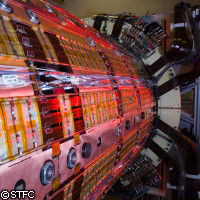'A fantastic moment': first beam fired at CERN's large hadron collider
The world's largest-ever physics experiment has got underway at the Large Hadron Collider (LHC) at CERN, the European Organization for Nuclear Research, in Switzerland. The first beam of protons successfully made its way around the 27 km particle accelerator on the morning of 10 September, to rounds of applause in the LHC Control Room and the great relief of the scientists, some of whom have been waiting for this day for years. The event paves the way for a new era of discoveries in the field of particle physics. Among other things, the LHC should help scientists answer some key questions about the universe, including the nature of dark matter, what happened right after the big bang, and how many dimensions there are. 'It's a fantastic moment,' said LHC project leader Lyn Evans. 'We can now look forward to a new era of understanding about the origins and evolution of the universe.' The LHC consists of a vast ring of superconducting magnets, 27 km in circumference, which lies 100 metres underground on the Franco-Swiss border outside Geneva. Inside the ring, two beams of particles (called hadrons) are accelerated around the ring in opposite directions. Powerful magnets guide the particles around the ring, and focus the beams before they meet, to boost the likelihood of two particles colliding. According to CERN, the tiny size of the particles involved means that making them collide is like 'firing needles from two positions 10 km apart with such precision that they meet half way'. Experimental stations positioned around the ring will detect what happens when particles collide. Their observations will hopefully help scientists to answer a wide range of key questions about the nature of the universe. The two largest experiments are ATLAS ('A toroidal LHC apparatus') and the CMS ('Compact muon solenoid'). These will both study the particles generated by the collisions, attempting to identify them and measure their paths and energies. The two experiments were designed independently and are based on very different technologies, so any discoveries made by one detector will be able to be cross-checked in the other one. One of the biggest mysteries the LHC will hopefully help us to unravel concerns the nature of mass. Put simply, we do not know why some particles weigh what they do, and why other particles appear to have no mass at all. Scientists believe a particle called a Higgs boson could explain the situation. The problem is that no-one has ever observed a Higgs boson, so its existence remains unproven. At the LHC, both the ATLAS and the CMS experiments will be on the look out for evidence of this mysterious particle. The LHC will also investigate dark matter. Although this substance makes up some 96% of the universe, we know very little about it. The ATLAS and CMS stations will be used to test theories regarding the make up of dark matter. Elsewhere at the LHC, the LHCb ('Large Hadron Collider beauty') experiment will probe the differences between matter and antimatter, and attempt to work out why nature appears to favour matter over antimatter. Meanwhile the ALICE ('A large ion collider experiment') station will investigate the conditions that prevailed in the immediate aftermath of the Big Bang. Finally, all the detectors will attempt to detect evidence of further, hidden dimensions of space. 'This is a historic moment in science; the culmination of decades of work,' commented Keith Mason, head of the UK's Science and Technology Facilities Council, which contributed to the LHC. 'Scientists waiting for the LHC dare to ask the biggest questions that exist in modern science. Whether we discover what we expect or have our theories completely overturned, the physics textbooks will never be the same again.' Between them, these experiments will generate vast amounts of data - roughly 15 million gigabytes - every year. This data will be managed and analysed with the help of a vast computing grid. Data will undergo initial processing at CERN before being distributed to 11 major computing centres around the world. These centres will pass the data on to 120 centres; these second tier centres have sufficient computing power to store much of the data and carry out complex analyses. Scientists around the world will then be able to access this data from computing clusters or even individual PCs. The switching on of the first beams at the LHC is a long-awaited moment for many scientists; the idea of building the LHC was first put forward in the early 1980s. In the following years, working groups discussed the kinds of questions such a machine could answer, and the CERN Council gave the green light to the project in 1994. Since then, work on the project has progressed steadily, and the final components of the LHC experiments were moved into position earlier this year. Finally, the entire structure was cooled to within a couple of degrees of absolute zero. In August, scientists successfully sent beams of particles down short lengths of the accelerator in both the clockwise and anti-clockwise directions. CERN's work is governed by its 20 Member States. The European Commission has observer status at the organisation.



